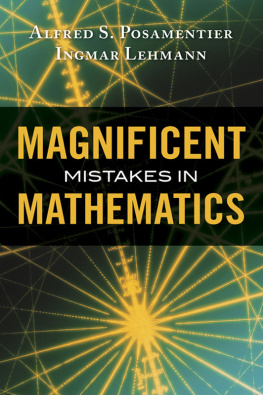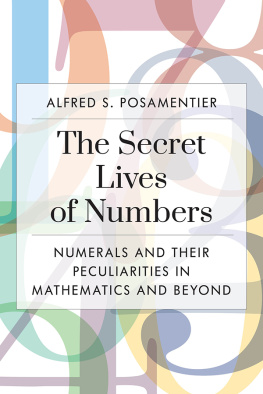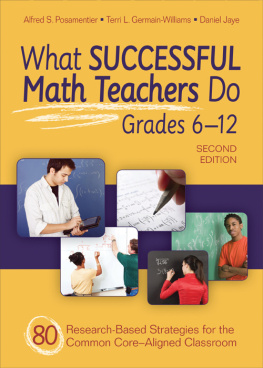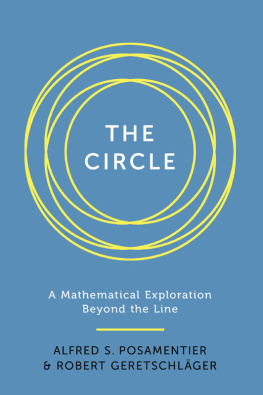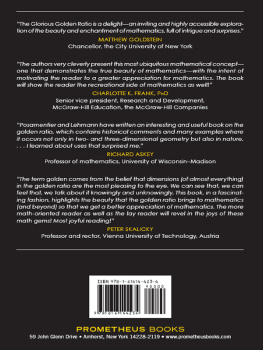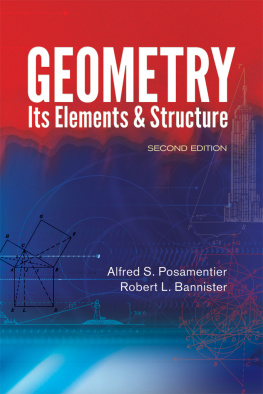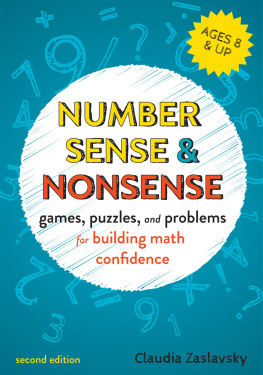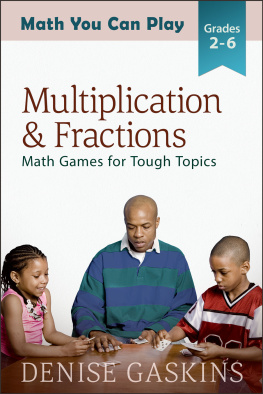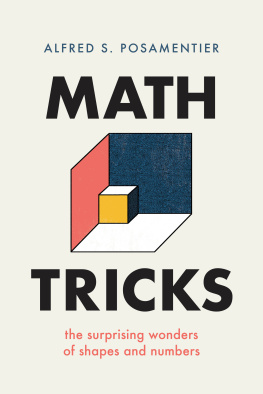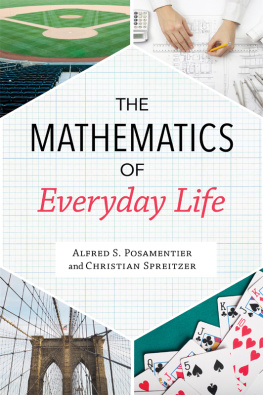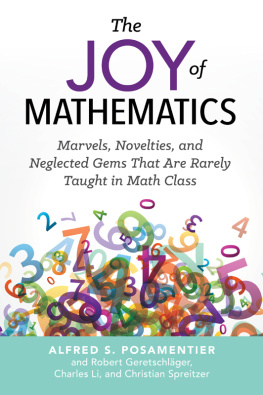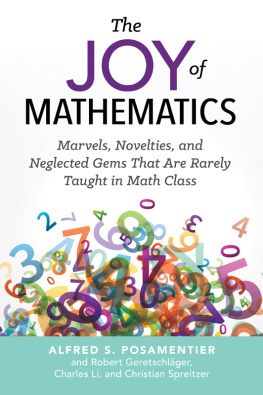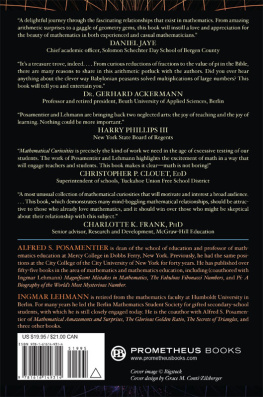
The authors wish to extend sincere thanks for proofreading and useful suggestions to Dr. Bernd Thaller, professor of mathematics at Karl Franzens UniversityGraz, Austria, and Dr. Peter Schpf, professor emeritus of mathematics at Karl Franzens UniversityGraz, Austria. Dr. Michael Engber, professor emeritus at the City College of the City University of New York provided some useful suggestions throughout the book. For some meticulous proofreading we sincerely thank Peter Poole. We also thank Catherine Roberts-Abel for very capably managing the production of this book and Jade Zora Scibilia for truly outstanding editing at the various phases of production.

Ball, W.W. Rouse. Mathematical Recreations and Essays. New York: Macmillan, 1960.
Barbeau, Edward J. Mathematical Fallacies, Flaws, and Flimflam. Washington, DC: Mathematical Association of America, 2000.
Bunch, Bryan H. Mathematical Fallacies and Paradoxes. New York: Van Nostrand Reinhold, 1982.
Campbell, Stephen K. Flaws and Fallacies in Statistical Thinking. Englewood Cliffs, NJ: Prentice-Hall, 1974.
Darmoryad, A. P. Mathematical Games and Pastimes. New York: Macmillan, 1964.
Dubnov, Ya. S. Mistakes in Geometric Proofs. Boston: D. C. Heath, 1963.
Dudeney, H. E. Amusements in Mathematics. New York: Dover, 1970.
Furdek, Atilla, Fehler-BeschwrerTypische Fehler beim Lsen von Mathematikaufgaben. Norderstedt: Books on Demand, 2002.
Gardner, Martin. Fads and Fallacies: In the Name of Science. New York: Dover, 1957.
. Perplexing Puzzles and Tantalizing Teasers. New York: Dover, 1988.
Havil, Julian. Impossible?Surprising Solutions to Counterintuitive Conundrums. Princeton, NJ: Princeton University, 2008.
. Nonplussed!Mathematical Proof of Implausible Ideas. Princeton, NJ: Princeton University, 2007.
James, Ioan. Remarkable Mathematicians. Cambridge: Cambridge University, 2002.
Jargocki, Christopher P. Science Brain-Twisters, Paradoxes, and Fallacies. New York: Charles Scribner, 1976.
Konforowitsch, Andrej G. Logischen Katastrophen auf der Spur. Leipzig: Fachbuchverlag, 1992.
Kracke, Helmut. Mathe-musische Knobelisken. Bonn: Dmmler, 1983.
Lietzmann, Walther. Wo steckt der Fehler? Leipzig: Teubner, 1952.
Madachy, Joseph. Mathematics on Vacation. New York: Charles Scribner, 1966.
Maxwell, E. A. Fallacies in Mathematics. London: Cambridge University Press, 1959.
Northrop, Eugene P. Riddles in Mathematics. Princeton, NJ: D. Van Nostrand, 1944.
O'Beirne, T. H. Puzzles and Paradoxes. New York: Oxford University, 1965.
Posamentier, Alfred S. Advanced Euclidean Geometry. Hoboken, NJ: Wiley, 2002.
. The Pythagorean Theorem: The Story of Its Power and Glory. Afterword by Nobel laureate Herbert Hauptman. Amherst, NY: Prometheus Books, 2010.
Posamentier, Alfred S., and Ingmar Lehmann. Mathematical Amazements and Surprises: Fascinating Figures and Noteworthy Numbers. Afterword by Nobel laureate Herbert Hauptman. Amherst, NY: Prometheus Books, 2009.
Schumer, Peter D. Mathematical Journeys. Hoboken, NJ: Wiley, 2004.
Scripta Mathematica 5 (1938) through 12 (1946).
White, William F. A Scrapbook of Elementary Mathematics. LaSalle, IL: Open Court, 1942.
Wurzel. Zeitschrift fr Mathematik (Jena, Germany) 38 (2004) through 46 (2012).

There are numerous conjectures by famous and less-famous mathematicians that have been published over the years. Some of these conjectures have been subsequently supported by proof, while some have been dismissed as mistaken, and others are still seeking verification or dismissal. Yet in all cases the attempts to grapple with these conjectures have moved our understanding of mathematics to the next level. Our journey through some of these conjectures will be to see what it took to verify them and what might have been found to dismiss them.
With a broad overview we can see that some of the greatest thinkersmathematicians and scientistshave made mistaken conjectures, many of which have led to new discoveries and a broadening of their respective fields. For example, Aristotle (384322 BCE), one of the most influential and well-known thinkers of all time, has made some mistaken statements. Although one might consider him one of the founders of science, and what he wrote has influenced generations, his errors have opened new fields of thought and study. Here a few of his mistaken beliefs:
- The world consists of five elements: fire, water, air, earth, and ether. The first four are nature on earth, and the fifth fills the heavens.
- Heavier weights fall to earth faster than lighter onesyet because of Galileo Galilei (15641642) we know better.
- Flies have four legs.
- Women have fewer teeth than men.
Aristotle also believed that the Earth was the center of the universe, and that the other observable bodiessuch as the moon, the sun, and the planetsrevolve around it. His words were quite influential in his time and lasted quite some time beyond. He influenced some of the other great thinkers such as Hipparchus of Nicaea (ca. 190120 BCE) and Claudius Ptolemy (ca. 100before 180). Not until Nicolaus Copernicus (14731543), Tycho Brahe (15461601), and Johannes Kepler (15711630) proved that the universe was solar centric did these earlier beliefs lose favor. Originally Kepler believed that the planets traveled on the surface of a spherewith a circular pathso as to be boxed in by the platonic solids. This was nicely supportive of Pythagoras's beliefs even though they were false! Later on, he corrected his erroneous conjecture by stating that the planets traveled on an elliptical path and described through his three famous laws the nature of the planet's travel along the elliptical pathperhaps one of the greatest achievements in astronomy and mathematics, and one that has solidified his fame forever.
Despite his enlightened thinking, Kepler still had a weakness for astrology. Similarly, Newton had a fascination with alchemy and a deep belief in religion and mystiques of numerology. This latter interest motivated Newton to produce thousands of pages of numerological calculations, which led him to predict that the world will come to an end in the year 2060. Was this a mistake?
While speaking of the earth, consider the most important mistake in the history of America. The Italian explorer Christopher Columbus (14511506), through his calculations, was convinced that the western route to India was considerably shorter than that in the easterly direction. This belief was based on the mistaken measurement by the astronomer Claudius Ptolemy, who calculated the circumference of the Earth to be 28,000 km. With this estimation for the earth's circumference, Columbus's conjecture would have been correct. However, the experts in the Spanish court assessed the earth's circumference at 39,000 km, which was arrived at by the Italian mathematician and cartographer Paolo Toscanelli (13971482). This calculation was incredibly accurate for the times, as it is quite close to the actual circumference of 40,075 km. Thus, Columbus's calculation was destroyed in the Spanish court. It was also common knowledge at the time that the earth was spherical, and thus Columbus was not trying to prove that it wasn't flat.
Next page
